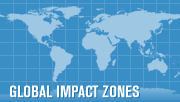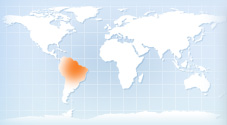Rising CO2 Levels Disrupt Rain Forest Growth Patterns

The Amazon rainforest is a critical influence on South American climate and one of the world's most important carbon banks. Covering almost as much land as the contiguous United States, the Amazon is home to 20 percent of the planet's animal and plant species and stores the equivalent amount of carbon as a decade of global fossil fuel emissions in its trees. It plays a crucial role in the precipitation cycle of South America and pumps oxygen into the atmosphere, earning it the nickname, the "Lungs of the World."
Global Warming Constricts the “Lungs of the World”
Home to 200 indigenous cultures and 30 million people, the Amazon rainforest is under increasing pressure to provide subsistence and prosperity, leading to deforestation. Each year, thousands of square miles of rainforest are cut down, releasing global warming pollution in the form of carbon dioxide and methane from burning and decaying vegetation.
The Amazon is an important repository of carbon and water. Deforestation disrupts the water cycle by allowing water to runoff directly to rivers rather than being trapped in soil and vegetation and slowly released throughout the year. This makes the forest more vulnerable to drought and the further loss of trees and release of global warming pollution.
Drought
Global warming is expected to result in more persistent El Niño conditions that shift the Amazon rainforest from a tropical forest environment towards dry savannah, imperiling an ecosystem that sustains local communities and one of the highest concentrations of biodiversity on Earth. Climate models predict a significant dieback of the Amazon rainforest by 2050 and project that the area will have larger losses of soil and plant carbon than of any other place on Earth by the end of the century.
This shrinking of the Amazon rainforest is a major reason why scientists predict that vegetation will shift from its current state as a carbon sink to a carbon source by the middle of the century.
Sources:
http://rainforests.mongabay.com/amazon/amazon_destruction.html; World Wildlife Fund; PEW Climate



